“Jules Winnfield! Our man in Inglewood” – Paul the Bartender in Pulp Fiction (1994)
A mere four miles northeast of busy Los Angeles International Airport, in the shadow of Randy’s Donuts, lies pastoral Inglewood Park Cemetery. Inglewood is a densely-populated urban area with a checkered past filled with racial tensions, street gangs and housing projects. But, in the center of its tangled freeways, empty lots and business-lined streets (where there seems to be a curious, yet highly-competitive, market for diapers – go figure? ) is a huge expanse of manicured green lawns and tall palms that over 35 thousand call their eternal home.
Inglewood Park is one of the most beautiful, well-maintained and well-marked cemeteries I have visited… and I have visited a lot. The main entrance is flanked by two multi-level mausoleums and an open-air memorial garden. The over 40 individual lawn plots are meticulously landscaped and dotted with a combination of ornate headstones and flat, ground-level plaques. The cement curbs are each painted with the name of the plot and there are round numbered section markers about every fifth grave making grave-hunting a relatively easy task. The far end of the cemetery has an auxiliary entrance and is situated next to a large structure featuring several chapels.
Inglewood Park, like many cemeteries, boasts some beautiful and unusual grave markers. (This giant mesh dome resting atop eight carved columns providing shelter for a massive white marble sarcophagus and this moss-covered statue of an angel are two examples.) I suppose family members need an easy way to find a loved one’s resting place and a gaudy or majestic monument is a good landmark. Or perhaps it was a stipulation in the will of the deceased, because even in death, egos need to be fed.
My family and I landed at LAX around 10:30 AM and we were pulling through the front gate of Inglewood Park Cemetery by 11:30 AM (after a stop at the aforementioned Randy’s). Although they do indulge me, Mrs. Pincus and my son, E., don’t exactly share my enthusiasm for cemeteries and that’s okay, because I don’t care much for Sex and The City or electronica bands. So while I explored, they slept in the rental car, stirring only when I asked for a lift to the next plot. Luckily, the weather was nice that morning and I enjoy walking among the departed. (Jeez… that’s sounds weird…)
I checked my map and charted my course, starting off in the direction of my first stop.
…and my first stop was an outdoor maze of polished gray marble walls called Capistrano Court. Here I found the grave of blues guitarist T-Bone Walker.
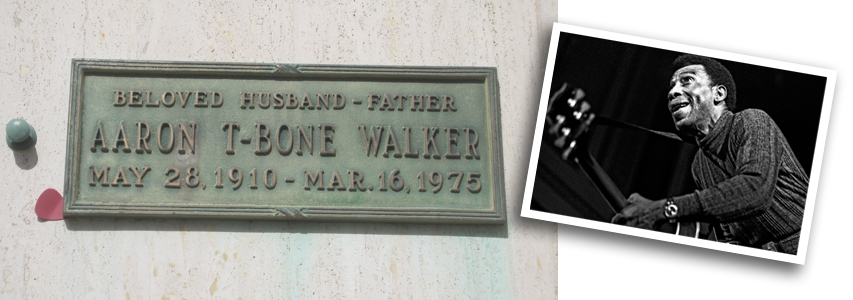
In addition to guitar, Walker played ukulele, banjo, violin, mandolin, and piano. He was cited as a musical influence by everyone from Chuck Berry to B.B. King to The Allman Brothers. Walker sometimes played the guitar with his teeth a trick Jimi Hendrix copied years later. (A previous visitor stuck a guitar pick behind the plaque.)
Near T-Bone Walker is the crypt of comedian LaWanda Page, best known as Fred Sanford’s nemesis “Aunt Esther” on the sitcom Sanford and Son.
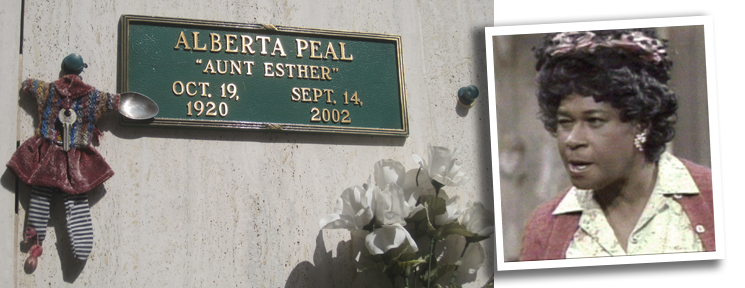
LaWanda began her career in show business as a fire-eater. She and Redd Foxx were actually very close friends from the time they were teenagers. LaWanda’s marker bears her real name – Alberta Peal. (No, the folk art rag doll was not left by me.)
Next to Capistrano Court is the massive two-story Mausoleum of the Golden West, a sprawling labyrinth of white marble corridors that end at intricate stained glass windows. The walls are lined with full-size crypts that reach six levels high. Several niche alcoves are filled with hundreds of brass plaques.

Golden West is the afterlife home of queen of the pin-ups, actress Betty Grable…
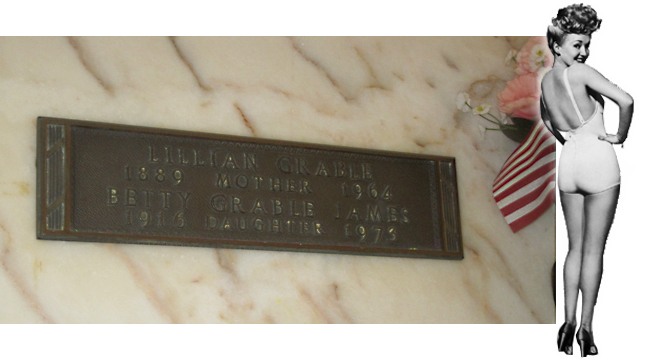
Betty was a true movie star in the 1930s and 40s. Her star began to fade in the 50s. When she lost the role of “Miss Adelaide” in 1956’s Guys and Dolls to Vivian Blaine, she retried from show business. Betty was married briefly to actor Jackie Coogan (“Uncle Fester” on TV’s The Addams Family) and then for over 20 years to bandleader Harry James. Harry is buried in a locked cathedral in a Las Vegas cemetery.
and, in another section, the legendary Ray Charles.
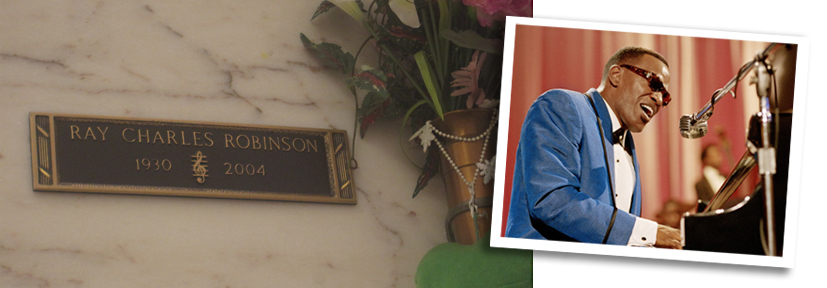
Ray was a pioneer and innovator in all genres of music – from jazz and gospel to pop and country. Frank Sinatra once called Ray “the only true genius in show business”.
In an alcove between Betty and Ray is the family monument of actor Cesar Romero.
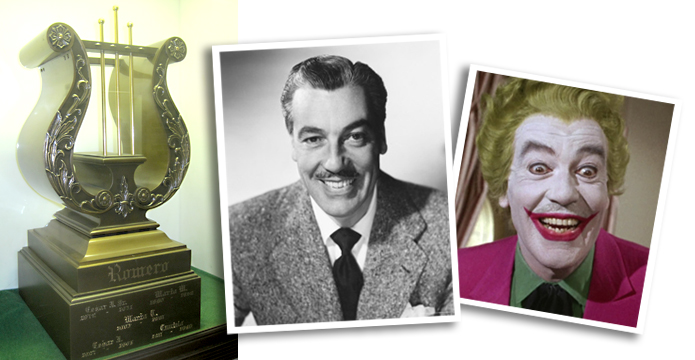
Romero played a series of Latin lovers and crafty villains from the 30’s through the 50’s, but he is best remembered as The Joker on the campy 1960’s TV show Batman.
On my way out of Golden West, this crypt caught my attention. She was either well-loved or family members are still bucking for an inheritance.
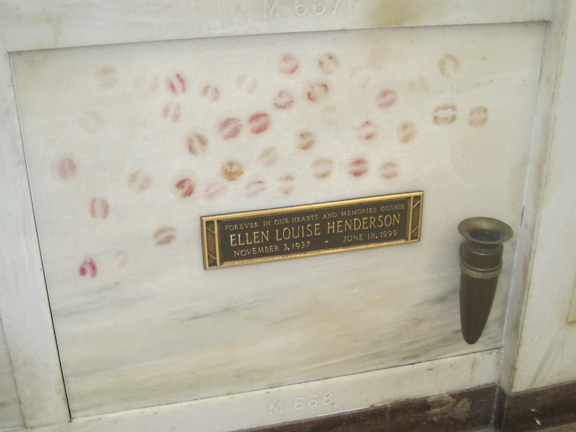
…and I’m pretty sure those things are for flowers.
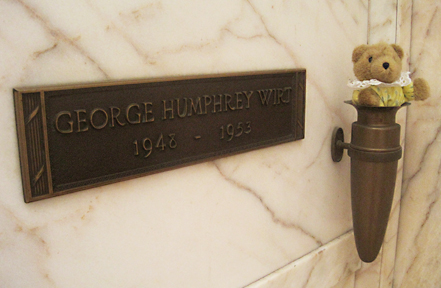
Crossing back across the entrance road, I entered the Sunset Mission Mausoleum, an indoor-outdoor mission-style building with a magnificent cathedral as its centerpiece. The halls are lined with beige marble wall crypts. Here I found singer-songwriter Richard Berry.
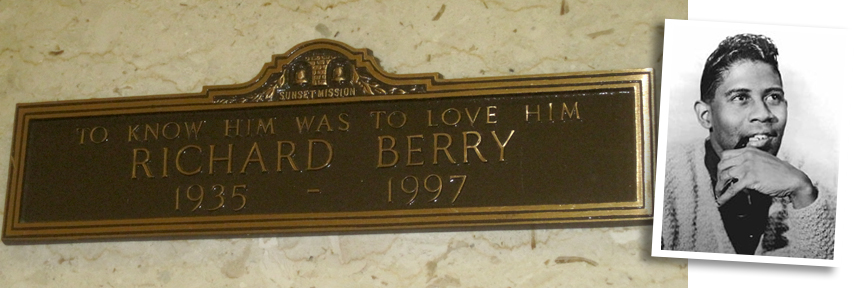
Berry wrote the frat-classic “Louie Louie”, a song that has been recorded over 1,000 times. However, Berry received little financial reward for its success, having sold the copyright for $750 in 1959 to pay for his wedding. In the mid-80s, a soft drink company wanted to use “Louie Louie” in a commercial and needed Berry’s consent. He was living on welfare in Los Angeles. A settlement was negotiated and Berry ended up a millionaire.
Upstairs in the Sunset Mission is the crypt of blues pianist Charles Brown.
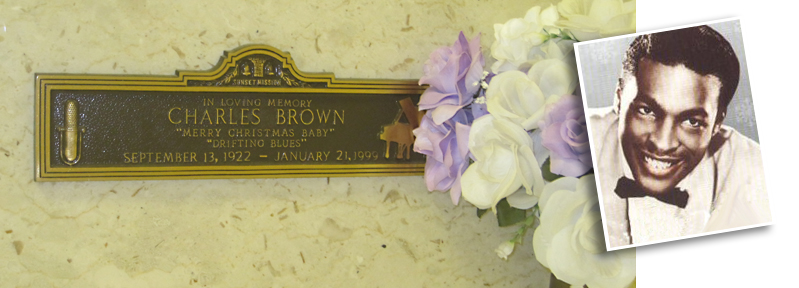
Brown is most famous for the hits “Drifting Blues” and the holiday favorite “Merry Christmas Baby”.
A few spaces down from Charles Brown is the incomparable Ella Fitzgerald, the “First Lady of Song”.
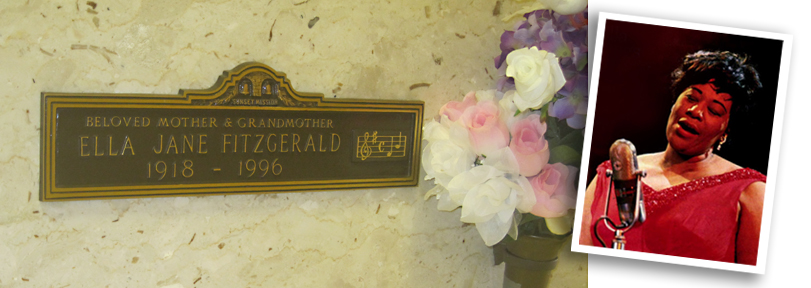
Over the course of her 59 year recording career, Ella won of 13 Grammy Awards and was awarded the National Medal of Arts by Ronald Reagan and the Presidential Medal of Freedom by George H. W. Bush. And she also broke a few wine glasses for Memorex and “scat sang” for KFC in commercials in the 70s.
Back outside, I spotted this elaborate sculpture of a weeping angel (a cemetery favorite) adorning the grave of Mary S. Ertl in the Sunny Slope section. Mary Ertl is believed to be the first female doctor to practice medicine in Los Angeles. There is also a memorial to her at the Forest Lawn cemetery in Glendale, although it is unclear which grave actually contains her remains.
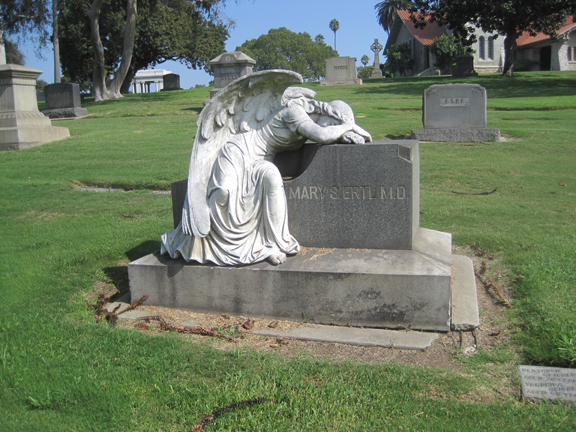
This is the approximate location of the unmarked Sunny Slope grave of Murry Wilson, father of Carl, Dennis and Brian Wilson of The Beach Boys.
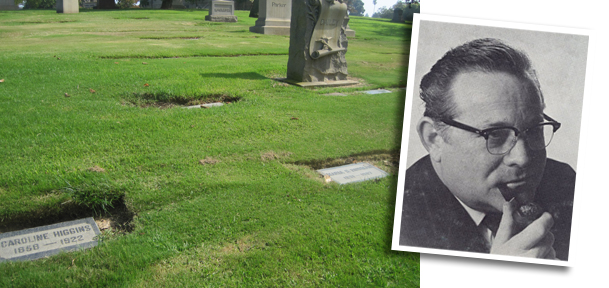
Winding through the narrow drives, I found the grave of rodeo champ and early Hollywood cowboy Hoot Gibson.
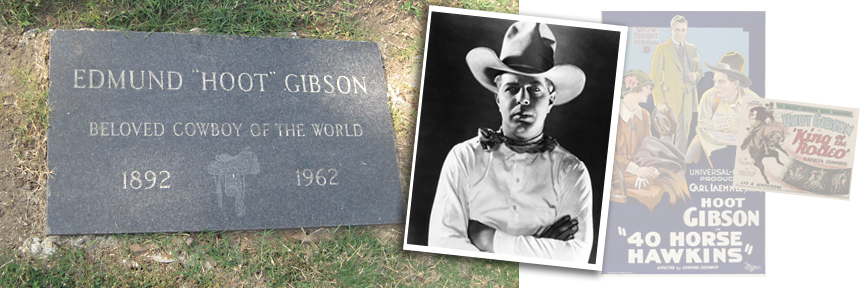
Gibson was a huge Western film star for years until singing cowboys, like Gene Autry, became more popular. Facing declining heath and financial difficulty, Gibson worked as a greeter in Las Vegas casinos in the 1950s and later in small carnivals, riding on his dwindling fame.
Near the center of Inglewood Park is the grave of circus family, the Flying Codonas.
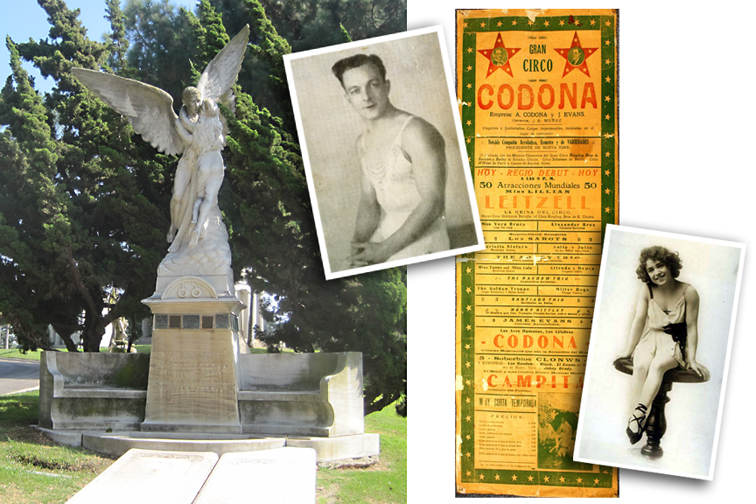
Alfredo Codona was a celebrated trapeze artist with the Ringling Brothers Circus in the early 20th century. He married fellow aerialist Lillian Leitzel in 1928. Lillian was performing in Copenhagen in 1931, when a rope snapped on her hand ring and she fell to her death. Alfredo was devastated. He commissioned this monument for her grave, depicting himself as an angel holding Lillian in his arms (note the two rings at the base of the sculpture; one with a broken rope). Alfredo married Vera Bruce, another acrobat, within a year of Lillian’s death. Alfredo was still distraught and his marriage to Vera was headed towards divorce. In 1937, at a meeting to divide their joint property, Alfredo shot Vera four times at her lawyer’s office and then turned the gun on himself and committed suicide. A note was found in his jacket pocket with instructions for his burial next to Lillian.
At the other end of the same section is the family plot of Edgar Bergen.
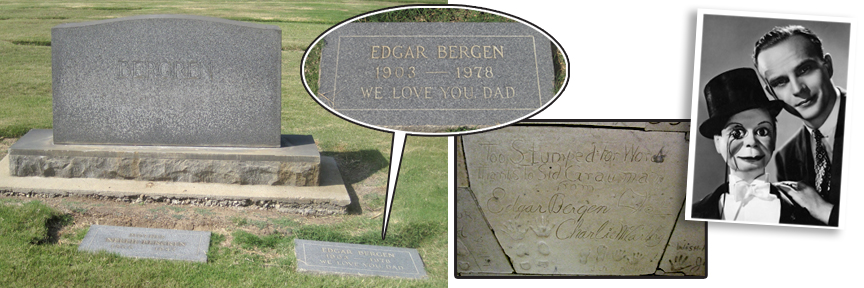
Bergen had one of the easiest jobs ever. He was a ventriloquist on the radio (think about it). Along with his famous wooden sidekicks Charlie McCarthy and Mortimer Snerd, Bergen remained popular for decades, even appearing in acting roles without his dummies (He played “Grandpa Walton” in the original Waltons pilot movie). He passed away three days after opening his “Farewell to Show Business” tour in Las Vegas. He was also the father of actress Candice Bergen. (Bergen’s signature and hand-prints in cement at Graumann’s Chinese Theater are accompanied by Charlie McCarthy’s.)
Next is the simple grave of flamboyant burlesque performer Gypsy Rose Lee.
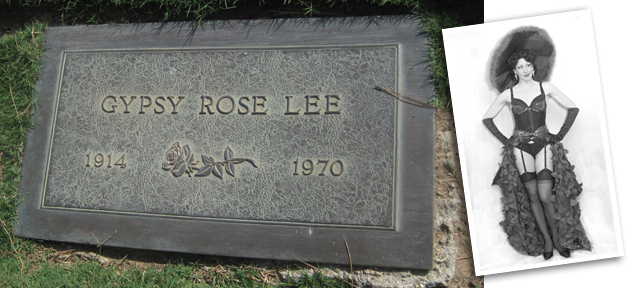
In addition to her international fame as a stripper, Rose was a prolific actress, author, playwright, art collector and philanthropist. Rose’s life was the subject of the popular musical Gypsy.
Across the lawn from Gypsy Rose is the grave of LaTasha Rogers, known professionally as MC Trouble.
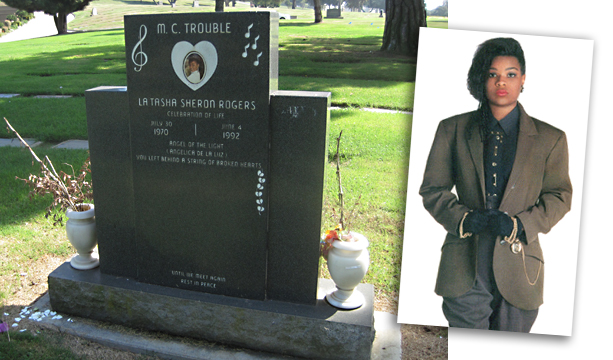
LaTasha was the first female rapper signed to Motown Records.
Two spaces over is Sugar Ray Robinson.
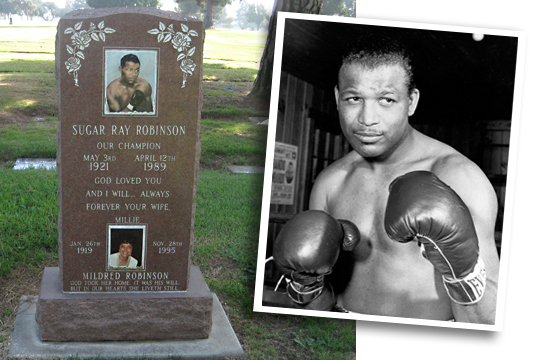
Robinson was ranked by the Associated Press and The Ring magazine as the greatest boxer in history. Muhammad Ali, who prides himself as “The Greatest”, recognized Robinson as the greatest boxer, in his opinion.
I dodged several commercial lawnmowers (I was at Inglewood Park on “Gardening Day”) to snap a picture of Allan “Rocky” Lane’s grave marker.
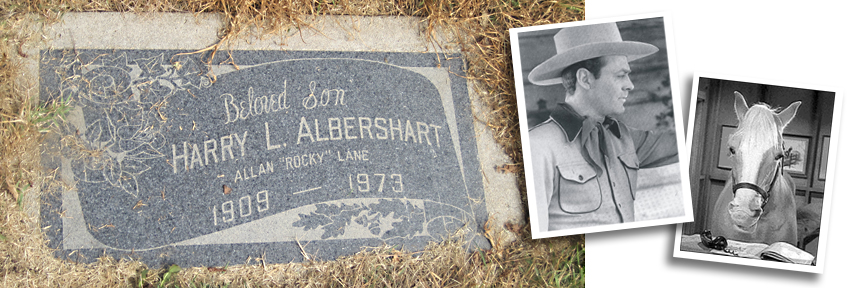
Originally the star of many B-grade Westerns, Allan went on to provide the voice for TV’s Mr. Ed on the show of the same name.
Against a chain-link fence in a far section of Inglewood Park is the grave of R & B singer Big Mama Thornton.
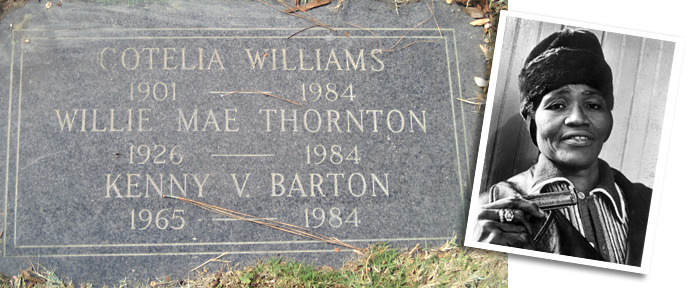
She was a popular singer and the first to record “Hound Dog”, later made famous by Elvis Presley. (Big Mama Thornton is most likely buried in Inglewood Park’s equivalent to “Potter’s Field”, an area dedicated to low-income burials, thus the multiple, unrelated names on her marker.)
Walking back (like an Egyptian), I came across this marker…
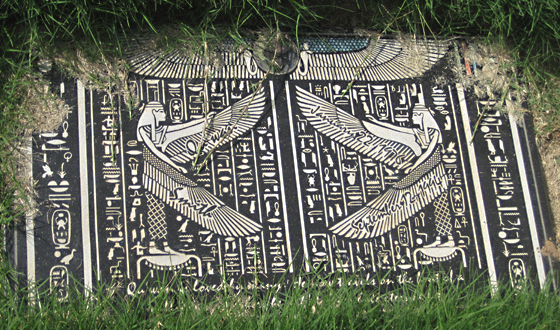
…although I didn’t see any pyramids around.
In the Garden of Peace outdoor columbarium, I found the crypt of musician Billy Preston.
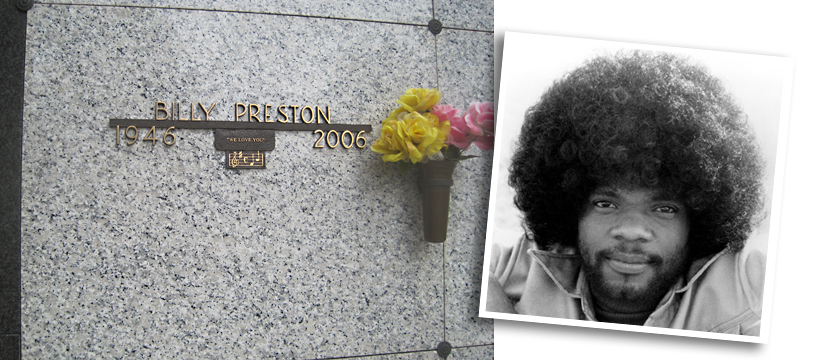
Billy, a talented and respected session keyboardist, was sometimes regarded as “The Fifth Beatle”, based on his contributions to the Fab Four’s studio recordings. Personally, I always regarded Ringo as the fifth Beatle.
Nearby is the grave of Cesare Cardini.
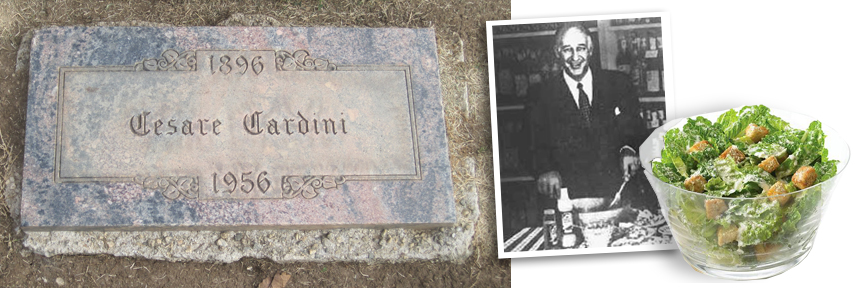
In 1924, Cardini invented the Caesar salad at his Tijuana restaurant.
Just behind Cesare Cardini’s grave is jazz trumpeter Chet Baker.
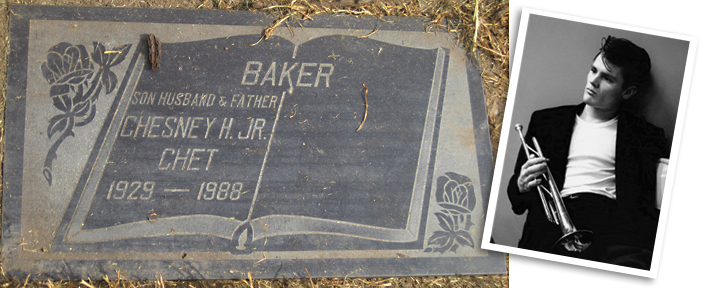
Baker was favorite collaborator of Dizzy Gillespie, Stan Getz and Charlie Parker. In later years, he played with Elvis Costello. He died from an apparent heroin overdose in The Netherlands.
In the huge Manchester Garden Mausoleum, I found baseball great Curt Flood.
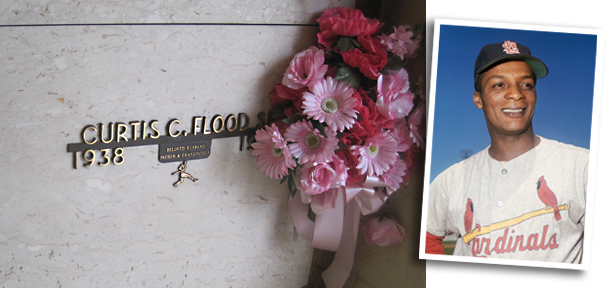
Curt pioneered free agency for baseball players when he fought a trade to the Philadelphia Phillies.
Just down the hall is actor/musician Jester Hairston.
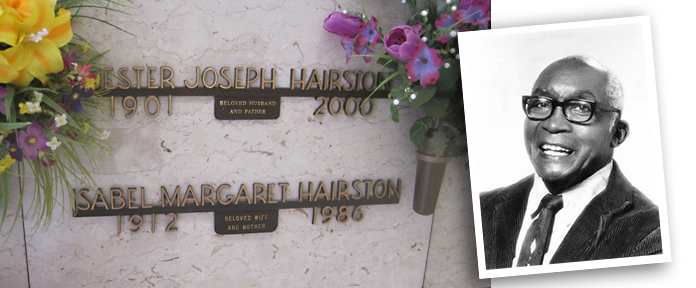
Jester, who is best known as feisty Rolly Forbes on the TV series Amen, had a long career in films. He appeared in small roles in The Alamo, To Kill a Mockingbird, In the Heat of the Night, Lady Sings the Blues, I’m Gonna Git You Sucka and Being John Malkovich. He also wrote the gospel-themed song “Amen” for the film Lilies of the Field and the Christmas perennial “Mary’s Boy Child”. Jester was one of the founding members of the Screen Actors Guild.
Opposite Jester’s crypt is noted architect Paul Revere Williams.
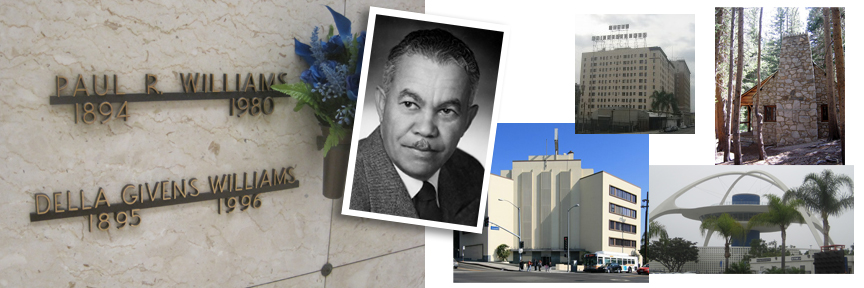
Williams designed many famous buildings in the Los Angeles area including the Hollywood YMCA, The Beverly Hills Hotel, Saks Fifth Avenue in Beverly Hills, Encounters Restaurant at LAX and the Shrine Auditorium. He designed homes for Frank Sinatra, Lucille Ball, Lon Chaney, Danny Thomas and many, many others.
In the Chapel of Honor in the Manchester Garden is attorney Johnnie Cochran’s crypt.
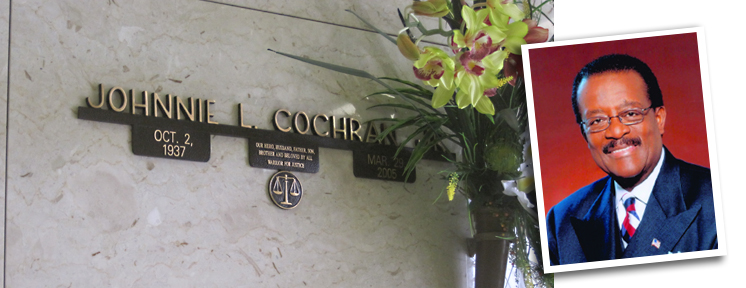
Cochran’s clients included Michael Jackson, Tupac Shakur, Sean Combs and Snoop Dogg. He is most famous, of course, as the leader of O.J. Simpson’s legal team and for the catchy defense poem “If it doesn’t fit, you must acquit.”
Although I had a map and detailed directions, I wandered around the Park Terrace section until a cemetery maintenance worker approached me to offer assistance. He asked who I was looking for and told me to write the name down on his clipboard. I carefully wrote the name. He made a call on his walkie-talkie and, getting no response, told me he’d be back after he checked with the main office. As he drove off in his pick-up truck, I walked over to the Acacia Slope Plot, passing this grave, decorated for the Halloween season…
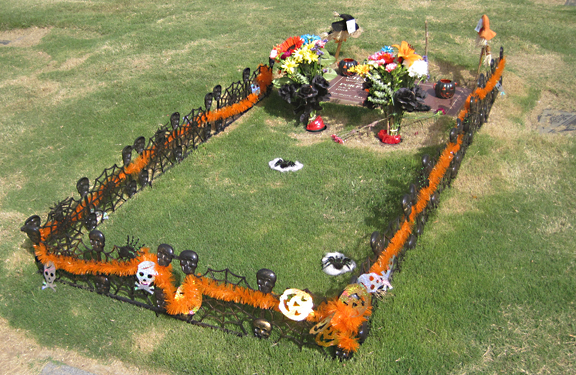
… until I found William Thomas’ grave.
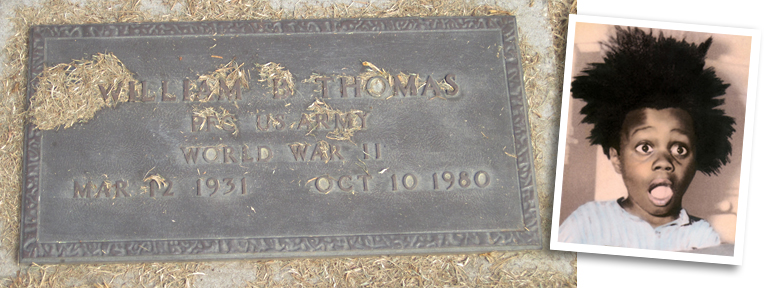
Thomas was better known as “Buckwheat” when he appeared in nearly 100 Our Gang/Little Rascals shorts in the 30s and 40s. His grave marker identifies him as a veteran of World War II. If that were the case, he would have been 14 years-old when he served. Actually, William was a decorated veteran of the Korean War in the 1950s.
I returned to the Park Terrace section and was met by my maintenance friend, who led me right to the grave I sought attorney Robert Kardashian.
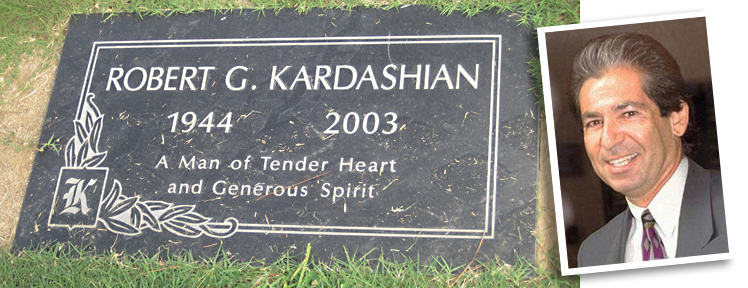
Kardashian was a friend of O.J. Simpson and even renewed his expired law license to offer legal assistance to Johnnie Cochran during Simpson’s controversial trial. Simpson’s infamous “low-speed chase” through Los Angeles began at Kardashian’s house. When Kardashian died, his widow married Olympic gold medalist Bruce Jenner and Kardashian’s children inexplicably became celebrities. I could have sworn I heard spinning noises coming from the grave. (Note: A reader pointed out that Kris Jenner actually divorced Kardashian prior to his death, so technically, she was not his widow. I honestly don’t give a shit.)
After a morning of traipsing through a cemetery, I woke my family (still sleeping in the car) and we headed to our next stop, which was – fittingly – Disneyland.
* * * * *

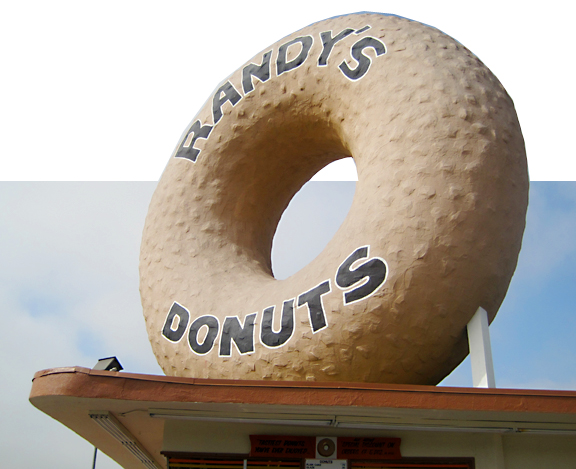

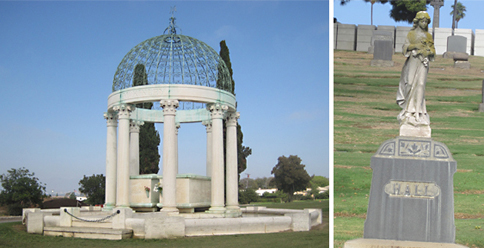
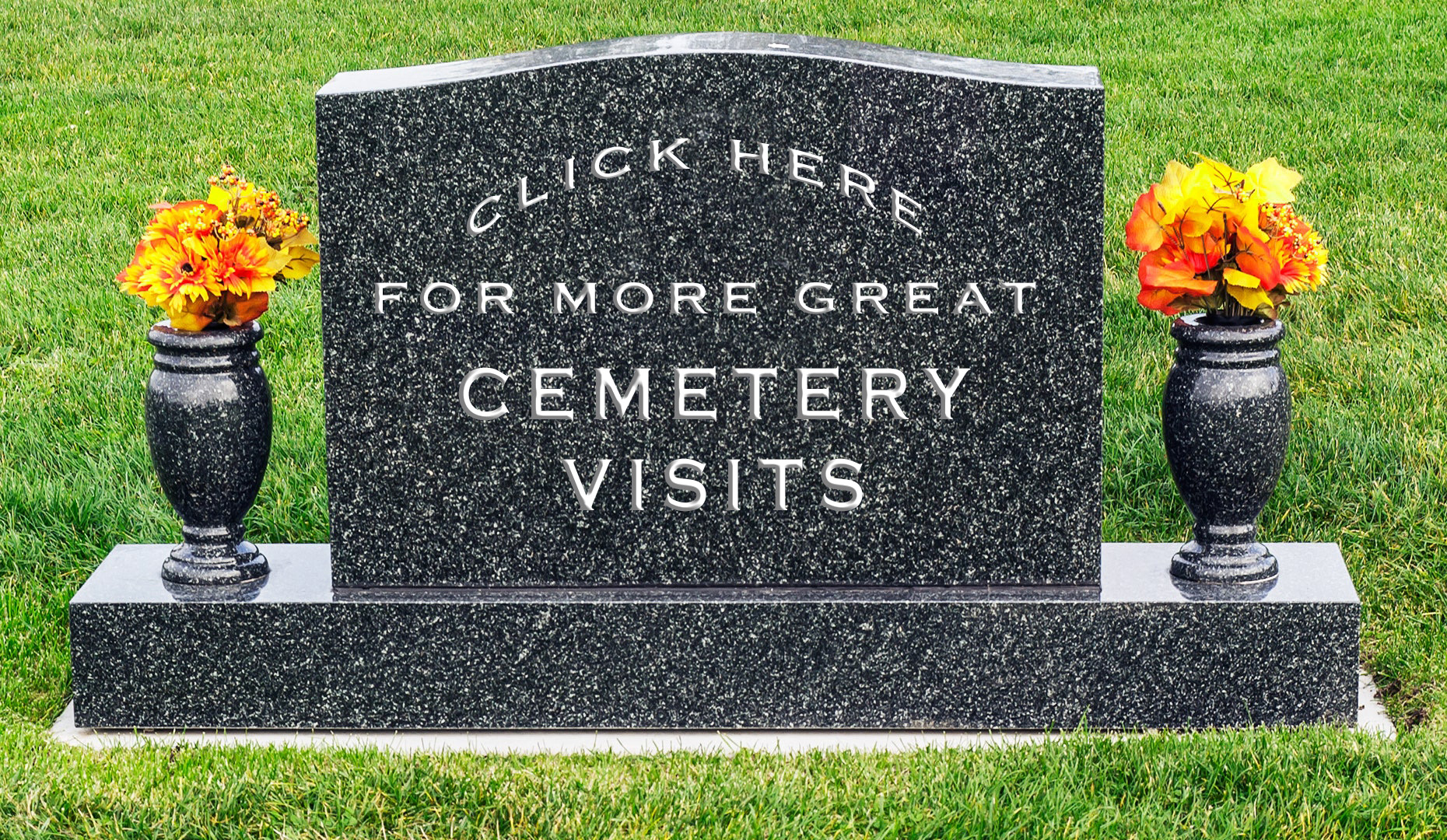
Some people go to Disneyland, others visit cemeteries.
I was just in Inglewood yesterday visiting Big Mama Thornton.
Thanks for the comment. Say “hi” to Big Mama for me!